贫穷经济学
【读书】经济学经典名著推荐

【读书】经济学经典名著推荐经济学作为一门重要的学科,在我们的日常生活中扮演着重要角色。
了解经济学的基本原理,可以帮助我们更好地理解和解决社会现象中的经济问题。
因此,阅读经济学的经典名著是我们提高经济素养的必经之路。
本文将为大家推荐几本经济学经典名著,希望能够对您的读书选择提供参考。
1.《资本论》《资本论》是由马克思创作的经济学经典名著,被誉为“科学社会主义的圣经”。
这本书主要探讨了资本主义社会生产关系的本质和发展趋势。
通过对商品和资本的分析,马克思揭示了资本主义经济体系中存在的利润追求、剥削劳动者、阶级矛盾等核心问题。
《资本论》的研究内容在现代经济学中仍然具有重要意义,对于理解资本主义经济的运行规律和社会变革具有指导作用。
2.《货币的性质和货币积累的本质》《货币的性质和货币积累的本质》是经济学家约翰·梅纳德·凯恩斯的代表作之一。
凯恩斯的著作对于宏观经济学的发展产生了重要影响。
这本书正是他对经济衰退和失业问题的深入研究成果。
凯恩斯通过对经济活动中的货币流动和储蓄投资关系的分析,提出了“有效需求”和“赤字支出”等概念,为经济政策制定者提供了对抗经济衰退的工具和思路。
《货币的性质和货币积累的本质》的出现,为经济学的发展开辟了新的道路,并推动了现代宏观经济学的繁荣。
3.《国富论》《国富论》是经济学家亚当·斯密的代表作之一,也是一本经典名著。
这本书被视为现代经济学的奠基之作,对经济学的发展产生了深远影响。
斯密在《国富论》中研究了市场经济体系的形成和功能,提出了“劳动分工”、“自由市场”、“价值理论”等重要概念。
同时,他对贸易理论和经济增长模型的研究也成为后续经济学家的重要参考。
《国富论》的出版不仅为经济学奠定了基础,也为后来的社会科学发展开辟了新的道路。
4.《行为经济学》《行为经济学》是经济学家理查德·塞勒的著作之一,也是一本在经济学领域引起广泛关注的经典名著。
塞勒在这本书中引入了心理学和经济学的交叉研究,旨在从行为和决策角度解释经济现象。
卢周来:要懂得穷人的经济学
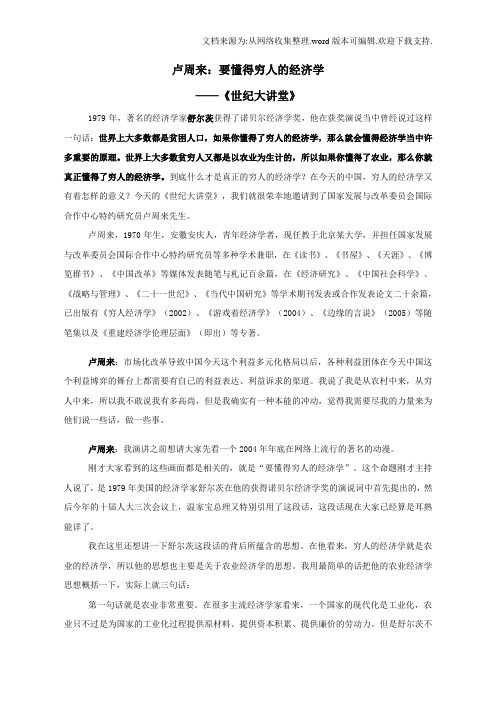
卢周来:要懂得穷人的经济学——《世纪大讲堂》1979年,著名的经济学家舒尔茨获得了诺贝尔经济学奖,他在获奖演说当中曾经说过这样一句话:世界上大多数都是贫困人口,如果你懂得了穷人的经济学,那么就会懂得经济学当中许多重要的原理。
世界上大多数贫穷人又都是以农业为生计的,所以如果你懂得了农业,那么你就真正懂得了穷人的经济学。
到底什么才是真正的穷人的经济学?在今天的中国,穷人的经济学又有着怎样的意义?今天的《世纪大讲堂》,我们就很荣幸地邀请到了国家发展与改革委员会国际合作中心特约研究员卢周来先生。
卢周来,1970年生,安徽安庆人,青年经济学者,现任教于北京某大学,并担任国家发展与改革委员会国际合作中心特约研究员等多种学术兼职,在《读书》、《书屋》、《天涯》、《博览群书》、《中国改革》等媒体发表随笔与札记百余篇,在《经济研究》、《中国社会科学》、《战略与管理》、《二十一世纪》、《当代中国研究》等学术期刊发表或合作发表论文二十余篇,已出版有《穷人经济学》(2002)、《游戏着经济学》(2004)、《边缘的言说》(2005)等随笔集以及《重建经济学伦理层面》(即出)等专著。
卢周来:市场化改革导致中国今天这个利益多元化格局以后,各种利益团体在今天中国这个利益博弈的舞台上都需要有自己的利益表达、利益诉求的渠道。
我说了我是从农村中来,从穷人中来,所以我不敢说我有多高尚,但是我确实有一种本能的冲动,觉得我需要尽我的力量来为他们说一些话,做一些事。
卢周来:我演讲之前想请大家先看一个2004年年底在网络上流行的著名的动漫。
刚才大家看到的这些画面都是相关的,就是“要懂得穷人的经济学”。
这个命题刚才主持人说了,是1979年美国的经济学家舒尔茨在他的获得诺贝尔经济学奖的演说词中首先提出的,然后今年的十届人大三次会议上,温家宝总理又特别引用了这段话,这段话现在大家已经算是耳熟能详了。
我在这里还想讲一下舒尔茨这段话的背后所蕴含的思想。
穷人经济学

人口质量方 面的成就
把人口质量当做一种稀缺资源,也就是它具有经济
价值,它的习得也需要花费投资,当收益大于成本时,
政府歧视农业,觉得农业是固有的落后的,尽管偶
尔有绿色革命但是对经济的贡献很少,经济发展被认 为是工业化的结果,政策偏向工业(压低农产品价 格)。
企业家精神 企业家才能
面对成本、回报、风险 很重要。 分配有限的资源。
分配的经济机会
不平衡的 不可避免
处理不均衡状态的能力,是指人们对于经济条件的变
化、更新所作出的反映及其效率,即人们根据经济条件 的变化,重新考虑合理分配自己的各种资源,如财产、 劳动、金钱及时间等。
就是受益人。
教育不仅仅是一种“消费”,这给人“开支”和 “节省”的感觉。在健康方面的投资也同样。
教育的支出很大程度上跟这个国家传统的储蓄和
投资有关。
技术工 熟练工
衡量人口质量, 医生、工程师、行政人员、会计、 各种研究科学家 技工 不可忽视。 对农业方面,印度为例,对农业研究的投资,回 报率为40% 高于大多数其他投资。 舒尔茨对1929-1957年美国教育投资与经济增长的关 系作了定量研究:各级教育投资的平均收益率为17%; 教育投资增长的收益占劳动收入增长的比重为70%;教 育投资增长的收益占国民收入增长的比重为33%。与其 他类型的投资相比,人力资本投资回报率很高。
李嘉图级差地租理论:
提出了地租存在的两个条件,即土地的有
限性、肥沃程度和位置上的差别性。 级差地租的数量取决于不同土地劳动生产率 差别。
用稀缺原理分析贫穷问题
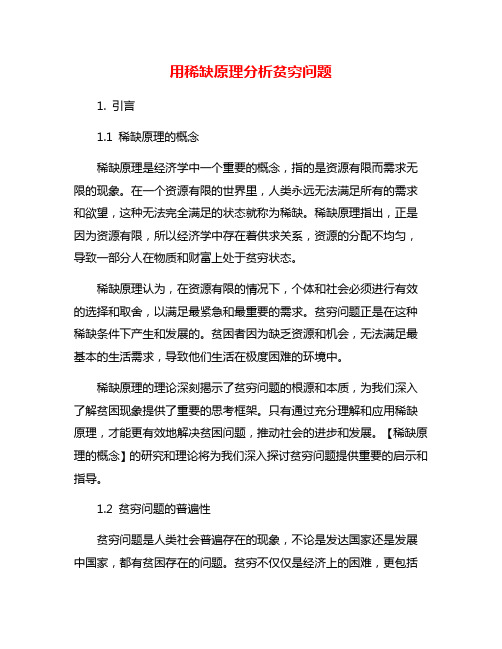
用稀缺原理分析贫穷问题1. 引言1.1 稀缺原理的概念稀缺原理是经济学中一个重要的概念,指的是资源有限而需求无限的现象。
在一个资源有限的世界里,人类永远无法满足所有的需求和欲望,这种无法完全满足的状态就称为稀缺。
稀缺原理指出,正是因为资源有限,所以经济学中存在着供求关系,资源的分配不均匀,导致一部分人在物质和财富上处于贫穷状态。
稀缺原理认为,在资源有限的情况下,个体和社会必须进行有效的选择和取舍,以满足最紧急和最重要的需求。
贫穷问题正是在这种稀缺条件下产生和发展的。
贫困者因为缺乏资源和机会,无法满足最基本的生活需求,导致他们生活在极度困难的环境中。
稀缺原理的理论深刻揭示了贫穷问题的根源和本质,为我们深入了解贫困现象提供了重要的思考框架。
只有通过充分理解和应用稀缺原理,才能更有效地解决贫困问题,推动社会的进步和发展。
【稀缺原理的概念】的研究和理论将为我们深入探讨贫穷问题提供重要的启示和指导。
1.2 贫穷问题的普遍性贫穷问题是人类社会普遍存在的现象,不论是发达国家还是发展中国家,都有贫困存在的问题。
贫穷不仅仅是经济上的困难,更包括教育、医疗、就业等多方面的困境。
而且贫困问题并不仅仅影响个体,也会对整个社会造成负面影响,如增加社会不稳定因素、加剧社会矛盾等。
贫困是一个复杂的系统性问题,减轻贫困需要从多个层面着手,包括政府政策、社会帮助、个人努力等方面。
了解贫困问题的普遍性有助于更好地认识这一社会现象,找到解决问题的有效途径。
在面对贫困问题时,充分认识其普遍性是理解贫困根源、寻找解决办法的重要基础。
探讨贫困问题的普遍性,有助于我们更深入地思考贫困现象背后的原因,从而更有针对性地制定解决贫困问题的措施。
2. 正文2.1 稀缺原理对贫穷问题的解释稀缺原理是指资源有限而需求无限的现象,导致人们在追求满足需要时必须做出选择。
在贫穷问题中,这一原理起着重要的解释作用。
贫穷在根本上可以被视为资源的稀缺。
贫困地区缺乏教育资源、医疗资源、就业机会等,导致居民无法得到基本的生活保障和提升机会。
你一定要读的50部经济学经典的读后感
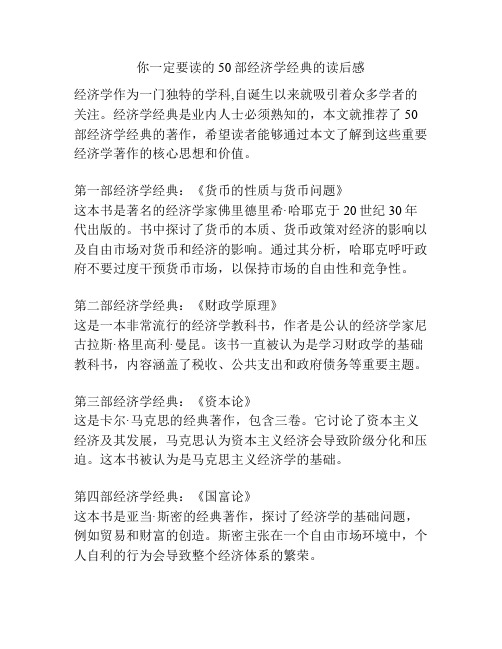
你一定要读的50部经济学经典的读后感经济学作为一门独特的学科,自诞生以来就吸引着众多学者的关注。
经济学经典是业内人士必须熟知的,本文就推荐了50部经济学经典的著作,希望读者能够通过本文了解到这些重要经济学著作的核心思想和价值。
第一部经济学经典:《货币的性质与货币问题》这本书是著名的经济学家佛里德里希·哈耶克于20世纪30年代出版的。
书中探讨了货币的本质、货币政策对经济的影响以及自由市场对货币和经济的影响。
通过其分析,哈耶克呼吁政府不要过度干预货币市场,以保持市场的自由性和竞争性。
第二部经济学经典:《财政学原理》这是一本非常流行的经济学教科书,作者是公认的经济学家尼古拉斯·格里高利·曼昆。
该书一直被认为是学习财政学的基础教科书,内容涵盖了税收、公共支出和政府债务等重要主题。
第三部经济学经典:《资本论》这是卡尔·马克思的经典著作,包含三卷。
它讨论了资本主义经济及其发展,马克思认为资本主义经济会导致阶级分化和压迫。
这本书被认为是马克思主义经济学的基础。
第四部经济学经典:《国富论》这本书是亚当·斯密的经典著作,探讨了经济学的基础问题,例如贸易和财富的创造。
斯密主张在一个自由市场环境中,个人自利的行为会导致整个经济体系的繁荣。
第五部经济学经典:《货币金融学》这是米尔顿·弗里德曼和安妮·斯卡格斯·弗里德曼的著作,被认为是当前货币和金融经济学领域的重要著作之一。
该书探讨了货币政策和金融市场的运作方式,以及政府对货币市场的干预对经济的影响。
第六部经济学经典:《货币、信用和银行》这本书是奥地利经济学家路德维希·冯·米塞斯的著作,于20世纪20年代出版。
此书探讨了货币和信用市场的运作机制以及它们对整个经济体系的影响。
米塞斯支持自由市场和金本位货币制度,反对政府干预。
第七部经济学经典:《人口论》这本书是托马斯·马尔萨斯的著作,于18世纪末出版。
贫困问题的经济学分析
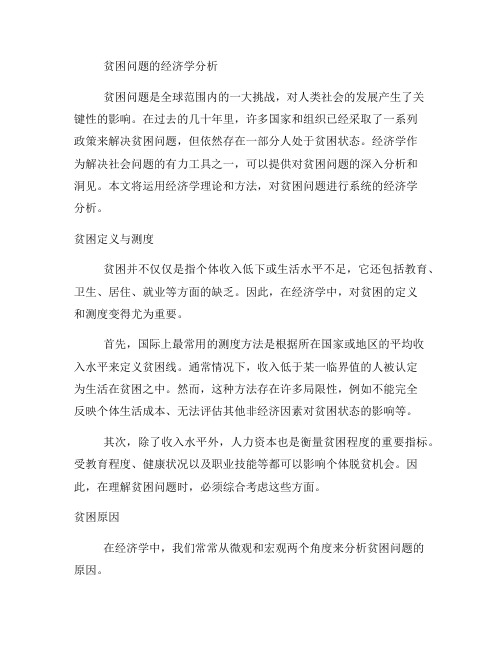
贫困问题的经济学分析贫困问题是全球范围内的一大挑战,对人类社会的发展产生了关键性的影响。
在过去的几十年里,许多国家和组织已经采取了一系列政策来解决贫困问题,但依然存在一部分人处于贫困状态。
经济学作为解决社会问题的有力工具之一,可以提供对贫困问题的深入分析和洞见。
本文将运用经济学理论和方法,对贫困问题进行系统的经济学分析。
贫困定义与测度贫困并不仅仅是指个体收入低下或生活水平不足,它还包括教育、卫生、居住、就业等方面的缺乏。
因此,在经济学中,对贫困的定义和测度变得尤为重要。
首先,国际上最常用的测度方法是根据所在国家或地区的平均收入水平来定义贫困线。
通常情况下,收入低于某一临界值的人被认定为生活在贫困之中。
然而,这种方法存在许多局限性,例如不能完全反映个体生活成本、无法评估其他非经济因素对贫困状态的影响等。
其次,除了收入水平外,人力资本也是衡量贫困程度的重要指标。
受教育程度、健康状况以及职业技能等都可以影响个体脱贫机会。
因此,在理解贫困问题时,必须综合考虑这些方面。
贫困原因在经济学中,我们常常从微观和宏观两个角度来分析贫困问题的原因。
从微观角度看,个体特征是导致贫困的一个重要因素。
这些特征包括受教育程度、技能水平、健康状况、家庭结构等。
缺乏教育和专业技能会限制个人就业机会,并可能导致低收入。
同时,健康状况差的人也会存在收入低下或无法正常工作的问题。
从宏观角度看,经济结构和制度环境也对贫困有重要影响。
落后的农业结构、缺乏投资和创新以及不平等的资源分配都可能导致贫困。
此外,高失业率、高通胀率和不稳定的宏观经济环境也会影响人们脱离贫困。
贫困陷阱与扶贫政策由于多重原因导致的贫困现象使得一些人陷入所谓“贫困陷阱”。
这种陷阱意味着个人难以摆脱贫困状态,并可能代代相传。
为了打破这种恶性循环,政府和国际社会开展了各种扶贫政策。
扶贫政策可以分为直接扶贫和间接扶贫两种形式。
直接扶贫主要包括现金转移、社会保障和基础设施建设等方式。
贫困经济学课件
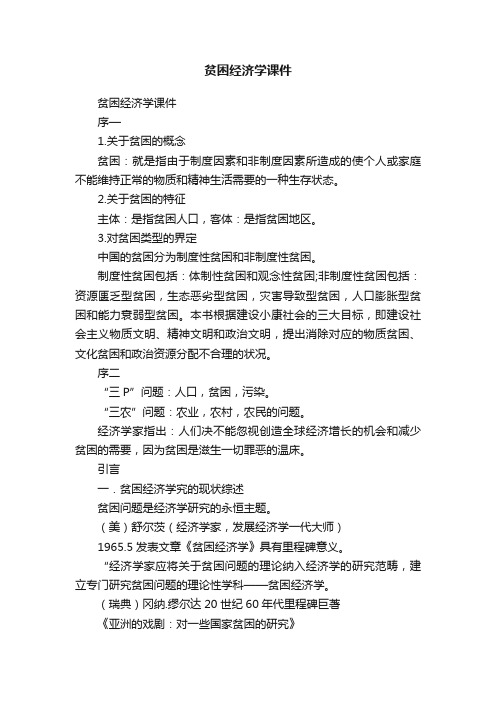
贫困经济学课件贫困经济学课件序—1.关于贫困的概念贫困:就是指由于制度因素和非制度因素所造成的使个人或家庭不能维持正常的物质和精神生活需要的一种生存状态。
2.关于贫困的特征主体:是指贫困人口,客体:是指贫困地区。
3.对贫困类型的界定中国的贫困分为制度性贫困和非制度性贫困。
制度性贫困包括:体制性贫困和观念性贫困;非制度性贫困包括:资源匮乏型贫困,生态恶劣型贫困,灾害导致型贫困,人口膨胀型贫困和能力衰弱型贫困。
本书根据建设小康社会的三大目标,即建设社会主义物质文明、精神文明和政治文明,提出消除对应的物质贫困、文化贫困和政治资源分配不合理的状况。
序二“三P”问题:人口,贫困,污染。
“三农”问题:农业,农村,农民的问题。
经济学家指出:人们决不能忽视创造全球经济增长的机会和减少贫困的需要,因为贫困是滋生一切罪恶的温床。
引言一.贫困经济学究的现状综述贫困问题是经济学研究的永恒主题。
(美)舒尔茨(经济学家,发展经济学一代大师)1965.5发表文章《贫困经济学》具有里程碑意义。
“经济学家应将关于贫困问题的理论纳入经济学的研究范畴,建立专门研究贫困问题的理论性学科——贫困经济学。
(瑞典)冈纳.缪尔达20世纪60年代里程碑巨著《亚洲的戏剧:对一些国家贫困的研究》《世界贫困的挑战——世界反贫困大纲》《富国和穷国:70年代的发展战略》(印度)阿玛蒂亚.森90年代末因对福利经济学和贫困问题研究获偌贝尔经济学奖阿玛蒂亚.森在谈到“9.11”时,也言及恐怖活动和贫困问题有关联的两点,第一,不惜生命投身于恐怖活动的志愿者中许多人抱着有一种对世界的不公平的反抗情绪,而贫困却是不公平的最大问题;第二,恐怖分子有必要制造一种理由使自己的行为正当化,对不公正宣战是一种制造正当化的理由。
第一编贫困的一般理论研究第一章. 贫困的基本概念:贫困和贫困线贫困:是一个动态的,历史的和地域的概念,它是随着时间和空间以及人们的思想观念的变化而变化。
读《穷人经济学》有感
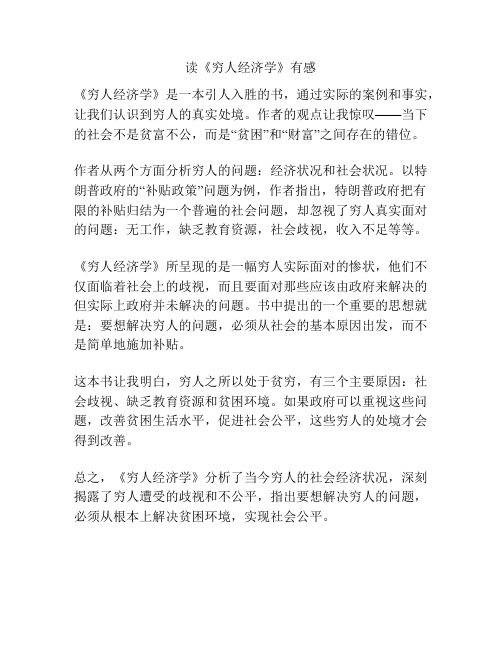
读《穷人经济学》有感
《穷人经济学》是一本引人入胜的书,通过实际的案例和事实,让我们认识到穷人的真实处境。
作者的观点让我惊叹——当下的社会不是贫富不公,而是“贫困”和“财富”之间存在的错位。
作者从两个方面分析穷人的问题:经济状况和社会状况。
以特朗普政府的“补贴政策”问题为例,作者指出,特朗普政府把有限的补贴归结为一个普遍的社会问题,却忽视了穷人真实面对的问题:无工作,缺乏教育资源,社会歧视,收入不足等等。
《穷人经济学》所呈现的是一幅穷人实际面对的惨状,他们不仅面临着社会上的歧视,而且要面对那些应该由政府来解决的但实际上政府并未解决的问题。
书中提出的一个重要的思想就是:要想解决穷人的问题,必须从社会的基本原因出发,而不是简单地施加补贴。
这本书让我明白,穷人之所以处于贫穷,有三个主要原因:社会歧视、缺乏教育资源和贫困环境。
如果政府可以重视这些问题,改善贫困生活水平,促进社会公平,这些穷人的处境才会得到改善。
总之,《穷人经济学》分析了当今穷人的社会经济状况,深刻揭露了穷人遭受的歧视和不公平,指出要想解决穷人的问题,必须从根本上解决贫困环境,实现社会公平。
农村贫困女性的经济学分析

1 政 治权 利不 足 。据 考察 , . 社会 权利 的贫 困就 是 指一 批 特 定 的群 体或 个人 , 法享受 社会 和法律 公认 的足 够数 量 和 无
质量 的政 治 、 工作 、 育 、 教 健康 、 名誉 、 闲、 赡养 、 休 被 以及 平 等
的性 别 权 利 , 且 由 于 他 们 应 该 享 有 的社 会 权 利被 削 弱 或 剥 而
在 初 中以下 , 有技术 专 长 , 多为 家 庭 妇女 , 龄偏 大 , 没 大 年 还
( )心理压 力 大 。农村 贫 困妇 女 由 于经 济 上 的低 收 三 入 性 和政治 上 的低 影 响力 , 使得 他们 的心理 焦 虑度更 高 于 一 般 社会 群体 : 生 活前途 悲观 、 望 , 有后 顾 之忧 , 对 失 常 衣食 之
力, 使得 公共 政策 的制 定有 利 于 自己 的利 益 需 求 , 者 至 少 或
不 影 响 自己 的 既 得 利 益 。农 村 贫 困 妇 女 群 体 由 于 较 少 参 与
社会政 治 活动 , 远离 社会 权 力 中心 , 至 有 些 人根 本 就 不 懂 甚 公 共权 力 和政治 影 响力 为何 物 , 加之 社 会 、 化舆 论 对 其 的 文 忽视 , 至蔑 视 , 村 贫 困妇 女政 治权 力 极 度 贫 乏 , 响 力 甚 农 影
均 收 入 , 至 跌 至 贫 困 线 以 下 。 在 其 消 费 结 构 中 , 格 尔 系 甚 恩 数 很 高 , 茅 草 房 、 过 时 衣 服 、 有 文 化 娱 乐 消 费 , 至 有 住 穿 没 甚 些 妇 女 食 不 果 腹 。还 有 最 重 要 的 是 , 农 村 女 童 严 重 失 学 。 在 ( )政 治 影 响 力 低 。 强 势 群 体 可 以 通 过 自 己 的 影 响 二
穷人经济学导论
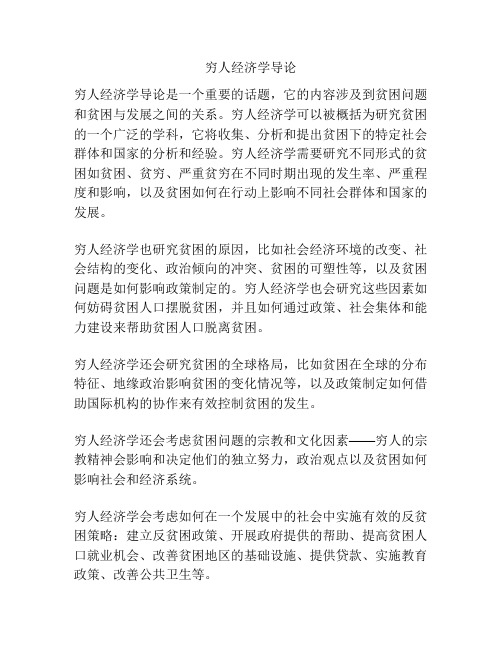
穷人经济学导论
穷人经济学导论是一个重要的话题,它的内容涉及到贫困问题和贫困与发展之间的关系。
穷人经济学可以被概括为研究贫困的一个广泛的学科,它将收集、分析和提出贫困下的特定社会群体和国家的分析和经验。
穷人经济学需要研究不同形式的贫困如贫困、贫穷、严重贫穷在不同时期出现的发生率、严重程度和影响,以及贫困如何在行动上影响不同社会群体和国家的发展。
穷人经济学也研究贫困的原因,比如社会经济环境的改变、社会结构的变化、政治倾向的冲突、贫困的可塑性等,以及贫困问题是如何影响政策制定的。
穷人经济学也会研究这些因素如何妨碍贫困人口摆脱贫困,并且如何通过政策、社会集体和能力建设来帮助贫困人口脱离贫困。
穷人经济学还会研究贫困的全球格局,比如贫困在全球的分布特征、地缘政治影响贫困的变化情况等,以及政策制定如何借助国际机构的协作来有效控制贫困的发生。
穷人经济学还会考虑贫困问题的宗教和文化因素——穷人的宗教精神会影响和决定他们的独立努力,政治观点以及贫困如何影响社会和经济系统。
穷人经济学会考虑如何在一个发展中的社会中实施有效的反贫困策略:建立反贫困政策、开展政府提供的帮助、提高贫困人口就业机会、改善贫困地区的基础设施、提供贷款、实施教育政策、改善公共卫生等。
穷人经济学还会研究贫困人口的解决方案,比如社会脱贫的技术,也就是如何做市场补偿、如何提高贫困人口的社会保障、如何实施社会政策等。
同时研究如何把贫困缩小化:通过改善社会政策和经济政策,以及平等的社会机会、教育和医疗等,减少贫困人口的数量。
这些都是穷人经济学导论所覆盖的内容。
穷人经济学

穷人经济学“我想起了诺贝尔奖获得者、一位叫舒尔茨的经济学家的一句话,他说世界大多数是贫困人口,如果你懂得了穷人的经济学,那么你就会懂得经济学当中许多重要的原理。
世界大多数贫穷人当中,又主要是以农业为生计的。
如果你懂得了农业,那你就真正懂得了穷人的经济学……”――这是温家宝总理在今年3月14日应邀出席全国人大三次会议举行的记者招待会上说的一番话;而舒尔茨的“穷人经济学”则出自他在1979年获得诺贝尔经济学奖时发表的获奖演说。
西奥多・舒尔茨曾担任芝加哥大学经济学系主任、美国经济学会会长,是“芝加哥学派”的代表人物之一,其代表作有《不稳定经济中的农业》、《改造传统农业》、《人力资本投资》、《报酬递增的源泉》等,他告诫人们:“一个社会的消费者中穷人太多、富人太富,迟早要出问题。
”所以,温总理在记者招待会上说:“……我不是经济学家,但我深知农业、农民和农村问题在中国的极端重要性。
没有农村的小康,就不会有全国的小康;没有农村的现代化,就不会有全国的现代化。
”可遗憾的是,我们中国的经济学家似乎更喜欢关注“富人经济学”,比如所谓“小康的标志是拥有第二套住房”、“堵车是一个城市繁荣的标志”、“房地产泡沫无碍经济的发展”、“中国经济怕冷不怕热”、“改革不可能避免国有资产流失”、“征收个人所得税不能‘杀富济贫’”、“中国人为什么穷?因为有‘仇富心理’”、“将基尼系数农村城市分开计算,这样中国贫富分化就不那么严重了”……面对人们的议论和批评,中国“富人经济学”的代表人物厉以宁教授在今年两会期间以政协委员的身份发出呼吁:“经济学家要有勇气顶住两方面的压力,一个是上面的压力,不做‘风派’;一个是互联网的压力,互联网上说什么的都有。
”而我们的温总理却在百忙之中喜欢到互联网上了解民情民意,他在这次记者招待会的开场白中就说:“昨天我浏览了一下新华网,网民们知道我今天开记者招待会,竟然给我提出了几百个问题。
他们对国事的关心,深深感动了我。
穷人经济学导论的读后感

穷人经济学导论的读后感穷人经济学是指一种致力于探索贫穷问题和穷人所面临的经济挑战的学科。
这种学科强调的是从个人和小团体经济决策的角度出发,以应对穷人所面临的挑战。
近年来,穷人经济学在经济学领域中越来越受到重视,并得到了广泛的研究和呼吁。
在《穷人经济学导论》一书中,作者 Abhijit V. Banerjee 和Esther Duflo 共同探讨了穷人经济学的概念和思想,并分享了他们在贫困问题上的研究成果和相关经验。
在我看来,这本书是一本引人入胜的学术读物,深入浅出地介绍了穷人经济学这一新兴领域,并为我们提供了许多对我们个人和全球来说都非常重要的见解。
首先,《穷人经济学导论》一书通过分析穷人所面临的现实经济挑战指出了当前穷人面临的最大经济问题,并构思了一系列应对策略。
为此,作者利用统计信息和丰富的案例研究来介绍了穷人日常生活中的各种挑战。
他们在书中介绍了一些关键领域,包括教育、卫生、保健和金融,这些领域是决定穷人可持续经济发展的关键要素。
在这些领域中,穷人经济学家为我们提供了一些关键性的解决方案,如优化公共教育系统、建立医疗和保健基础设施和解决信贷问题,来帮助人们有效应对贫困问题。
其次,本书通过分析穷人所面临的经济难题,强调了其中的困难性和多样性。
穷人所面临的问题并不是可以简单地被解决的,这需要我们对每个挑战采取个体化的响应。
例如,书中指出,关于贷款给穷人的问题,不同的国家和地区有不同的访问门槛,且每个穷人都面临着不同的负担。
这需要我们了解各个地区、文化和社会的差异,进而根据个体的特征来定制解决方案。
我们需要为穷人提供真正的人性化服务,并且调整政策来满足大众的需求。
此外,本书还提供了一种创新的方法来回答穷人经济学中的重要问题。
由于行为经济学和实证经济学的飞速发展,并使我们对个体和群体行为的理解更加深入。
穷人经济学家们在这方面也做得很好,他们采用了各种新颖的技术来简化并定制从实际行动中收到的简单、实用的数据。
贫困概念的经典释义——贫困经济学理论探讨之一.

贫困概念的经典释义——贫困经济学理论探讨之一形式逻辑学认为,概念是反映客观现象或客观现象本质属性的基本思惟形式。
概念的认识价值在于,能在对象中找到本质的、一般的东西。
毫无疑问,科学的贫困概念则是反映贫困现象本质属性的一种抽象。
因此,研究贫困问题,必须首先把握贫困概念的科学涵义。
自从人类进入文明社会以后,贫困便一直成为迄今为止各社会形态中一种常见的社会现象。
对于贫困这一社会存在,人们可以从感性上直觉它,但似乎很难从概念上把握它。
也就是说,对于社会中的贫困,人们能较容易地根据一些现象,如缺吃少穿、营养不良、没有足够收入、无法获得教育和医疗卫生服务等来作出感性判断,但真正对贫困作出抽象判断并对其一般概念给出准确、科学的定义,并不是一件容易的事。
因为,在不同的历史时代、不同的社会制度、不同的经济背景下,贫困的特征是大不相同的。
同时,不同的政治信仰、不同的价值观念和不同社会身份的人,对于贫困的理解和评价也是大不相同的。
正因如此,有些学者对贫困概念的科学涵义的可知性表示怀疑,陷入相对主义和不可知论的困惑之中。
美国经济学家萨缪尔森认为,“贫困是一个非常难以捉摸的概念”,“贫困一词对不同的人意味着不同的事情”(萨缪尔森著:《经济学》第14版,上册,第658页,北京经济学院出版社)。
英国学者奥本海默也认为:“贫困本是一个模糊概念,它不具备确实性。
它随时间和空间以及人们的思想观念变化而变化。
”古今中外,许多思想家、经济学家、社会学家等,对“贫困”这一概念的涵义作出了种种解释。
较为经典的主要有以下几类:(一)中国的传统解释——财货贫乏论中国古汉语对“贫”、“穷”、“困”的释义主要是指处于财货匮乏的境况。
关于“贫”,《说文》释义:“贫,财分少也。
”《广韵·真韵》曰:“贫,乏也,少也。
”关于“穷”,《广雅·释诂四》释义:“穷,贫也。
”也就是说,“贫”与“穷”含义大体相同,都是指缺乏财物。
但“贫”与“穷”有量或程度方面的差别。
贫穷的本质第一章报告

贫穷的本质第一章报告第一章:贫穷的定义和表现贫穷是人类社会中普遍存在的问题,其本质和表现形式也有着不同的阐述。
本章将从贫穷的定义和表现两个方面探讨贫穷的本质。
一、贫穷的定义贫穷的定义可以从经济学、社会学、心理学等不同角度进行解释。
从经济学的角度来看,贫穷可以被定义为一种物质资源缺乏的状态。
其表现在生活条件恶劣、物质匮乏、购买力不足等方面。
从社会学的角度来看,贫穷则更多地关注贫穷者在社会分层中的位置,以及这种位置对他们的生活和机会的影响。
从心理学的角度来看,贫穷则包括了贫穷者的情感和人际关系方面的困难。
综上所述,贫穷的定义既包括了物质层面的缺乏,也包括了社会身份和心理状态方面的表现。
二、贫穷的表现1. 生活条件恶劣贫穷者的生活条件通常比较恶劣,他们可能生活在贫民窟、棚户区、废墟堆积等不利的环境中。
他们的住所可能没有基本的供水、供电、供暖等条件,甚至没有足够安全的饮用水和卫生设施。
这些条件的缺乏会影响贫穷者的身体健康和生活品质。
2. 物质匮乏贫穷者通常缺乏足够的物质资源,这包括了食物、衣物、住房和医疗等方面。
他们可能无法获得足够的营养,也可能没有足够干净的衣服、床铺等基本物品。
他们可能只能生活在简陋的住所中,无法获得适当的医疗保健服务。
3. 贫困地位的影响贫穷者的贫困地位还会对他们的生活和机会产生影响。
这些影响可能包括了就业、教育、社交机会等方面。
贫穷者可能没有受过足够的教育,也可能没有足够的资金去寻找合适的就业机会。
此外,他们还可能面临社交隔离和歧视等问题。
综上所述,贫穷的表现不仅包括了物质层面的缺乏,还包括了社会身份和心理状态方面的表现。
结论:贫穷的本质并不简单,包括了物质层面的缺乏、社会身份的影响以及心理状态方面的障碍。
只有全面分析贫穷的定义和表现,才能更好地解决贫穷问题。
贫困理论ppt课件

4
3、 欧共体: • 1989年 :贫困应该被理解为个人、家庭和群体的资源——包括
物质的、文化的和社会的——如此有限,以至于他们被排除在 他们所处的国家可以接受的最低限度的生活方式之外。
4、 中国学者: • 童星、林闽在《我国农村贫困线标准研究》一文中对贫困的定
7
3、国际劳工组织: • 在工业化国家,贫困线大体上应相当于制造业工人平均
工的30%。
4、美国: • 贫困线标准是根据家庭人数和所在州来决定 • 美国大陆相连接的48个州和首都华盛顿为一个标准(两
口之家2008年贫困线标准为14,000美元, 2009年贫困线 标准为14,570美元) • 阿拉斯加和夏威夷分别有自己的标准
收入提 高
劳动生 产率提
高
正循环
生活水 平提高
劳动力 素质提
高
21
(5)阿玛蒂亚·森:权利贫困理论 • 森理论的独特魅力在于深刻分析了隐藏在贫困背后的生
产方式的作用,以及贫困的实质。 • 森主要研究的是贫困的特殊形态——饥饿。他认为要理
解饥饿,必须首先理解权利体系,并把饥饿放在权利体 系中加以分析。 • 饥饿是交换权利的函数,不是食品供给的函数。
义:贫困是经济、社会、文化落后的总称,是由最低收入造成 的缺少生活必需品和服务以及没有发展机会和手段的一种生活 状况。
5
(二)贫困类型
• 根据贫困的内涵:广义的贫困和狭义的贫困 • 根据贫困的成因:普遍性贫困、制度性贫困、区
域性贫困和阶层性贫困 • 根据绝对性与相对性:绝对贫困和相对贫困
6
(三)贫困标准
• 主张发展经济的最终目的应当是惠及全体人民的幸福。
贫困问题的经济学分析
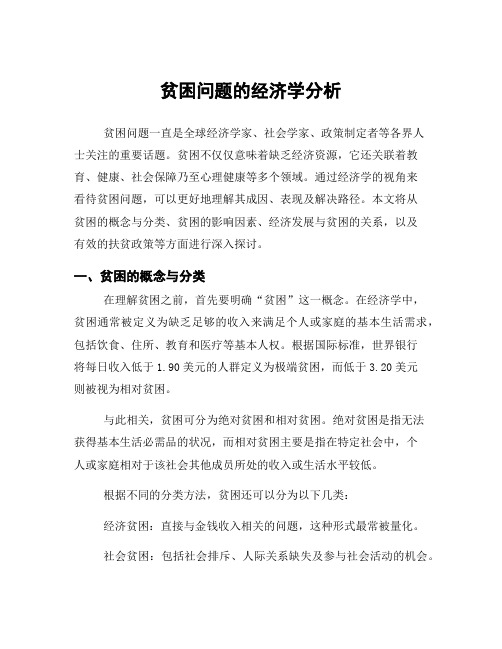
贫困问题的经济学分析贫困问题一直是全球经济学家、社会学家、政策制定者等各界人士关注的重要话题。
贫困不仅仅意味着缺乏经济资源,它还关联着教育、健康、社会保障乃至心理健康等多个领域。
通过经济学的视角来看待贫困问题,可以更好地理解其成因、表现及解决路径。
本文将从贫困的概念与分类、贫困的影响因素、经济发展与贫困的关系,以及有效的扶贫政策等方面进行深入探讨。
一、贫困的概念与分类在理解贫困之前,首先要明确“贫困”这一概念。
在经济学中,贫困通常被定义为缺乏足够的收入来满足个人或家庭的基本生活需求,包括饮食、住所、教育和医疗等基本人权。
根据国际标准,世界银行将每日收入低于1.90美元的人群定义为极端贫困,而低于3.20美元则被视为相对贫困。
与此相关,贫困可分为绝对贫困和相对贫困。
绝对贫困是指无法获得基本生活必需品的状况,而相对贫困主要是指在特定社会中,个人或家庭相对于该社会其他成员所处的收入或生活水平较低。
根据不同的分类方法,贫困还可以分为以下几类:经济贫困:直接与金钱收入相关的问题,这种形式最常被量化。
社会贫困:包括社会排斥、人际关系缺失及参与社会活动的机会。
文化贫困:源于缺乏文化资本,如教育不足导致获取知识和技能的机会受限。
二、贫困的影响因素影响贫困现象发生的因素多种多样,可以从微观和宏观两个层面进行分析。
微观因素微观层面的因素直接影响个人或家庭的生存状况,主要包括:教育水平:教育是决定个体收入的重要因素,高水平的教育通常会带来更高的就业机会和收入水平。
许多研究表明,受教育程度较低的人群更容易陷入长期贫困中。
就业机会:就业机会的缺乏使得一些人难以挣取足够的收入来维持生计。
在经济不景气或转型期间,就业岗位减少,失业率上升,这些都加剧了贫困问题。
健康状况:健康问题直接影响工作能力和生产力。
身体健康和心理健康都是个体能否成功工作的基础,而常见疾病或精神健康问题可能导致个体无法继续工作,加重家庭负担。
宏观因素宏观层面的因素涉及更广泛的经济与社会结构,包括:经济增长率:整体经济状况对于减少贫困至关重要。
什么是贫穷?
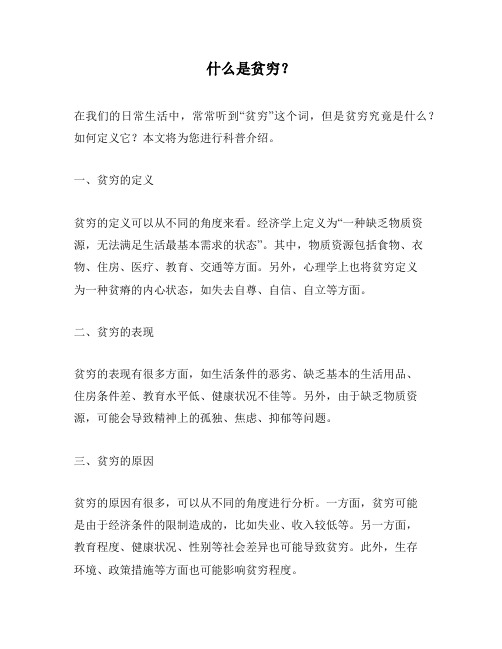
什么是贫穷?在我们的日常生活中,常常听到“贫穷”这个词,但是贫穷究竟是什么?如何定义它?本文将为您进行科普介绍。
一、贫穷的定义贫穷的定义可以从不同的角度来看。
经济学上定义为“一种缺乏物质资源,无法满足生活最基本需求的状态”。
其中,物质资源包括食物、衣物、住房、医疗、教育、交通等方面。
另外,心理学上也将贫穷定义为一种贫瘠的内心状态,如失去自尊、自信、自立等方面。
二、贫穷的表现贫穷的表现有很多方面,如生活条件的恶劣、缺乏基本的生活用品、住房条件差、教育水平低、健康状况不佳等。
另外,由于缺乏物质资源,可能会导致精神上的孤独、焦虑、抑郁等问题。
三、贫穷的原因贫穷的原因有很多,可以从不同的角度进行分析。
一方面,贫穷可能是由于经济条件的限制造成的,比如失业、收入较低等。
另一方面,教育程度、健康状况、性别等社会差异也可能导致贫穷。
此外,生存环境、政策措施等方面也可能影响贫穷程度。
四、贫穷的解决方法要解决贫穷问题,需要综合考虑多方面因素。
一方面,政府可以出台政策措施,提高教育水平、改善就业环境、建立社会保障等。
另一方面,社会各界也可以通过慈善捐款、志愿者服务、公益活动等方式为贫困人口提供资助和帮助。
五、贫穷对社会的影响贫穷问题不仅影响个人,也影响整个社会。
一方面,贫穷可能导致社会不稳定,引发社会矛盾和不满情绪。
另一方面,贫穷也会制约社会的经济发展,减缓社会进步的步伐。
贫穷是一个多维度的问题,其影响和表现形式都非常复杂。
我们应该更加关注贫困人群,积极探索有效的解决方案,从而实现社会的可持续发展。
经济学原理贫穷的原因是
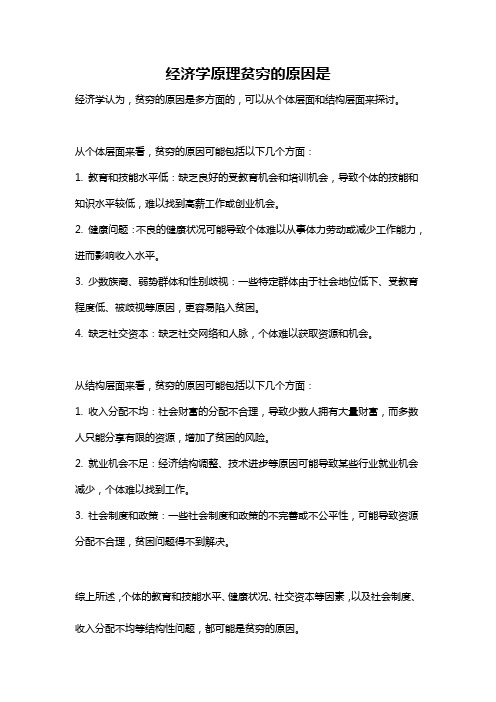
经济学原理贫穷的原因是
经济学认为,贫穷的原因是多方面的,可以从个体层面和结构层面来探讨。
从个体层面来看,贫穷的原因可能包括以下几个方面:
1. 教育和技能水平低:缺乏良好的受教育机会和培训机会,导致个体的技能和知识水平较低,难以找到高薪工作或创业机会。
2. 健康问题:不良的健康状况可能导致个体难以从事体力劳动或减少工作能力,进而影响收入水平。
3. 少数族裔、弱势群体和性别歧视:一些特定群体由于社会地位低下、受教育程度低、被歧视等原因,更容易陷入贫困。
4. 缺乏社交资本:缺乏社交网络和人脉,个体难以获取资源和机会。
从结构层面来看,贫穷的原因可能包括以下几个方面:
1. 收入分配不均:社会财富的分配不合理,导致少数人拥有大量财富,而多数人只能分享有限的资源,增加了贫困的风险。
2. 就业机会不足:经济结构调整、技术进步等原因可能导致某些行业就业机会减少,个体难以找到工作。
3. 社会制度和政策:一些社会制度和政策的不完善或不公平性,可能导致资源分配不合理,贫困问题得不到解决。
综上所述,个体的教育和技能水平、健康状况、社交资本等因素,以及社会制度、收入分配不均等结构性问题,都可能是贫穷的原因。
《贫穷的本质》的经济解读

《贫穷的本质》的经济解读贫穷的本质,一直是经济学领域内的一个热门话题,对于大多数人而言也是一个极具现实意义的问题。
张五常教授曾经说过:“经济学的核心就是贫富差距的解释和调节。
”贫穷的本质到底是什么?本文将从经济学的角度出发,深入解读贫穷的本质及其影响。
一、贫穷的定义贫穷通常是指一个人或者一个家庭无法维持其基本的生活需求,同时也无法参与到社会文化活动中去。
按照联合国的定义,贫穷的标准是指一个人每日收入低于1.9美元(PPP),而极端贫穷的标准则是每日收入低于1.25美元(PPP)。
这些指标通过衡量人均收入来判断贫穷,但这种判断方法并不能很好地反映出贫穷的本质以及其影响。
二、贫穷的原因贫穷的原因是多种多样的,其中一些是由于个人的原因,如不良的生活习惯和缺乏教育,而另一些则是由于环境或政策等不可控因素所导致的。
根据世界银行的数据,大多数贫困发生在非洲和南亚的农村地区,这些地区受到了诸如战争、自然灾害和政治不稳定等因素的影响,使得这些地区的人们更难以脱困。
同时,贫穷也有一部分原因与经济发展有关。
在经济增长的过程中,富人和贫人之间的贫富差距会产生,并逐渐加剧。
一些发展中国家的政治体系、产权制度和教育水平也并不完善,这都为贫富差距的扩大提供了土壤。
三、贫穷的影响贫穷不仅对个人本身的生活和发展产生了消极的影响,也会对整个社会和其它领域产生消极的影响。
1. 健康:贫穷的人往往会接触到更多的疾病,同时由于缺乏医疗条件和良好的卫生,他们的健康非常脆弱。
2. 教育:贫穷家庭的孩子通常没有机会获取良好的教育资源。
同时,由于经济贫困,这些孩子可能被迫辍学以增加家庭收入。
3. 经济:由于缺乏资本和投资等条件,贫穷的人往往无法参与到经济中去,并且可能会构成负面反馈环节,导致经济长期停滞。
4. 社会影响:贫穷的人丧失了参与社会文化活动的机会,受到社会、政府和家庭的排斥,从而导致更加严重的社会问题,例如犯罪、家庭暴力等。
四、解决贫穷的方法在经济学领域内有许多解决贫穷的方法,其中最常见的是通过政府的政策来缩小贫富差距,提供更多的教育和就业机会,和提供更好的医疗和社会保障。
- 1、下载文档前请自行甄别文档内容的完整性,平台不提供额外的编辑、内容补充、找答案等附加服务。
- 2、"仅部分预览"的文档,不可在线预览部分如存在完整性等问题,可反馈申请退款(可完整预览的文档不适用该条件!)。
- 3、如文档侵犯您的权益,请联系客服反馈,我们会尽快为您处理(人工客服工作时间:9:00-18:30)。
I came from a small town in China which most of the people there have an average income about $5 per day. Therefore I can say that most of the people there are living in the poverty. When I get elder, I have been in U.S. Los Angeles for 3 years and India Bangalore for half a year due to work dispatching. And I have been Africa for several times during my vacations. Now I am in Japan. Compared with American and Japanese children, I found that so many children are living in such a poor livelihood in China India and Africa. Unsurprisingly, for the most of those countries are agricultural based countries. Every year, 9 million children die before their fifth birthday; they have no medical attention, no education, and no future. My personal experience and what I saw motivate me to setup my research plan as Global Poverty.Based on my personal understanding the reason why poor people are living in poverty may be attributed to below four sections:·Poverty lines in many countries were originally set to capture the notion of poverty based on hunger·Basic health care services in most countries is failed to offer to the poor.·Many families could not afford sending their children to school or local school labor is in shortage.·The overwhelming population against finite income.However, I believe there is a root cause for above four reasons or can be summarized as one: Currency. And we cannot simply trust that the poor could help themselves out and become rich eventually because the Poverty Trap does exist:The S-shape of this curve is the source of the poverty trap. On the diagonal line, income today is equal to income tomorrow. For the very poor that are in the poverty trap zone, income in the future is l ower than income today. This means that over time, those in this zone become poor and poor and they will eventually end up trapped in poverty, at point N.An expert from the worl d of high finance always says that the poor are like hedge-fund managers-they live with huge amounts of risk. The only difference is in their levels of income. In fact, he grossly und erstates the case: No hedge-fund manager is liable for 100 percent of his losses, unlike almost every small business owner and small farmer. Moreover, the poor often have to raise all of the capital for their busi nesses, either out of the accumulated “wealth” of their families or by borrowing from somewhere, a circumstance most hedge-fund managers never have to face.Then what can the pool to do to cope with these risks? A natural reaction when faced with a drop in wages or earnings is to try to work more. But this may sometimes be self-d efeating. If all the poor laborers want to work more when times are bad, they compete with each other, which drives wage down. The best bet I believe is often to try to limit exposure to risk by building, like a hedge-fund manager, a diversified portfolio, and it is cl ear that the poor invest a lot of ingenuity in doing so. Generally I believe there are three approaches:·Holding multiple plots in different parts of the village, rather than one single large plot, also provides some risk diversification.·temporary migration can also be interpreted in this light.·Being very conservative in the way they manage their farms or their business.All of these ways in which the poor cope with risk tend to be very costly, consequently most of areas are choosing below strategies: One is to become someone’s share tenant, meaning that the landlord pays a part of the cost of farming and claims a part of the output. This limits the farmer’s risk exposure at the cost of incentives, however, knowing that the landlord will take half of whatever comes out of the ground, the farmers has less reason to work very hard; Another way is having multiple occupations, as many poor people do, is also inefficient, simply because it is hard to become a specialist in anything without specializing in it. So how to find the best fit and the most profit portfolio investment for those people? Can this portfolio be adapted to any part of the poor area? These two questions lead to my research purpose and research significance.One way to approach to the answers is Information collecting, background research and field Investigation (Questionnaire and Interview). Find the commonality of all the solutions, exaggerate it, optimize it and then put it back in the field for the test. That will be my research method for this task as well.The key of the future is the education of the children at present. I sincerely hope my research will help improving the children’s living conditions and educations in those countries, let them have the smile of which originally belongs to them, the same smile as other countries’ children do.References:1.Jeffrey Sachs, The End of Poverty, 20052.Abhijit Vinayak Banerjee and Esther Duflo, Poor Economics, 20113.United Nations, Department of Economic and Social Affairs, The Millennium DevelopmentGoals Report, 2010。
